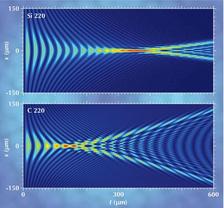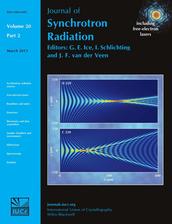Two-dimensional distribution of the intensity. The case of a 220 reflection: (above) silicon (below) diamond. (Credit: Authors)
Hard X-ray free-electron lasers, like the Europen XFEL presently under construction, generate sequences of ultra-short spatially coherent pulses of X-ray radiation. Scientists from DESY, Kurchatov Institute Moscow and MEPhI Moscow proposed a spectrometer for XFELs based on the effect of diffraction focusing that theoretically allows an energy resolution of ∆E/E≈2∙10-6 to be achieved. This resolution is better than in most available spectrometers, and in principle should allow to resolve the fine structure of individual XFEL pulses.
These pulses can be less than 100 fs in duration, and have an energy spectrum of relative width ∆ω/ω≈10-3. The XFEL pulse energy spectrum changes chaotically from pulse to pulse due to Self-Amplified Spontaneous Emission (SASE) process. Moreover the fine structure of a XFEL pulse has a characteristic width of the order of ∆ω/ω≈10-6 for hard X-ray energies. Therefore, it is important to develop a spectrometer with sufficient resolution to resolve this fine structure of individual XFEL pulses.
The effect of diffraction focusing occurs in a single-crystal plate due to dynamical scattering, and is similar to focusing in a Pendry lens made from metamaterial with a negative refraction index. The incoming divergent beam is focused at each energy near the Bragg angle. Since the Bragg angle depends on the energy, X-rays with different energies will be focused at different points just behind the crystal under conditions of focusing. Due to this property a high-resolution spectrometer is feasible.
The authors investigated different crystals and possible reflections and came to the conclusion that most suitable ones are silicon and diamond single crystals with the 220 reflection. In order to measure the full spectrum, the incoming beam should have sufficient divergence. This can be obatined by focusing the incoming beam with compound refractive lenses (CRL). A spectrometer based on diffraction focusing should be an ideal tool for the spectral analysis of individual pulses of the present and future hard X-ray FELs. Furthermore it should be easy to operate and can be installed at any hard X-ray FEL beamline.
The work was done in the frame of Russian-German Cooperation and was supported by BMBF Project No. 05K10CHG ‘Coherent Diffraction Imaging and Scattering of Ultrashort Coherent Pulses with Matter’ in the framework of the German–Russian collaboration ‘Development and Use of Accelerator-Based Photon Sources’.
(from authors)
Cover story Journal of Synchrotron Radiation, G. Kohn, O. Y. Gorobtsov and I. A. Vartanyants. "Spectrometer for hard X-ray free-electron laser based on diffraction focusing", J. Synchrotron Rad., vol.20, part 2, 258-265 (2013), DOI: 10.1107/S0909049513000903








